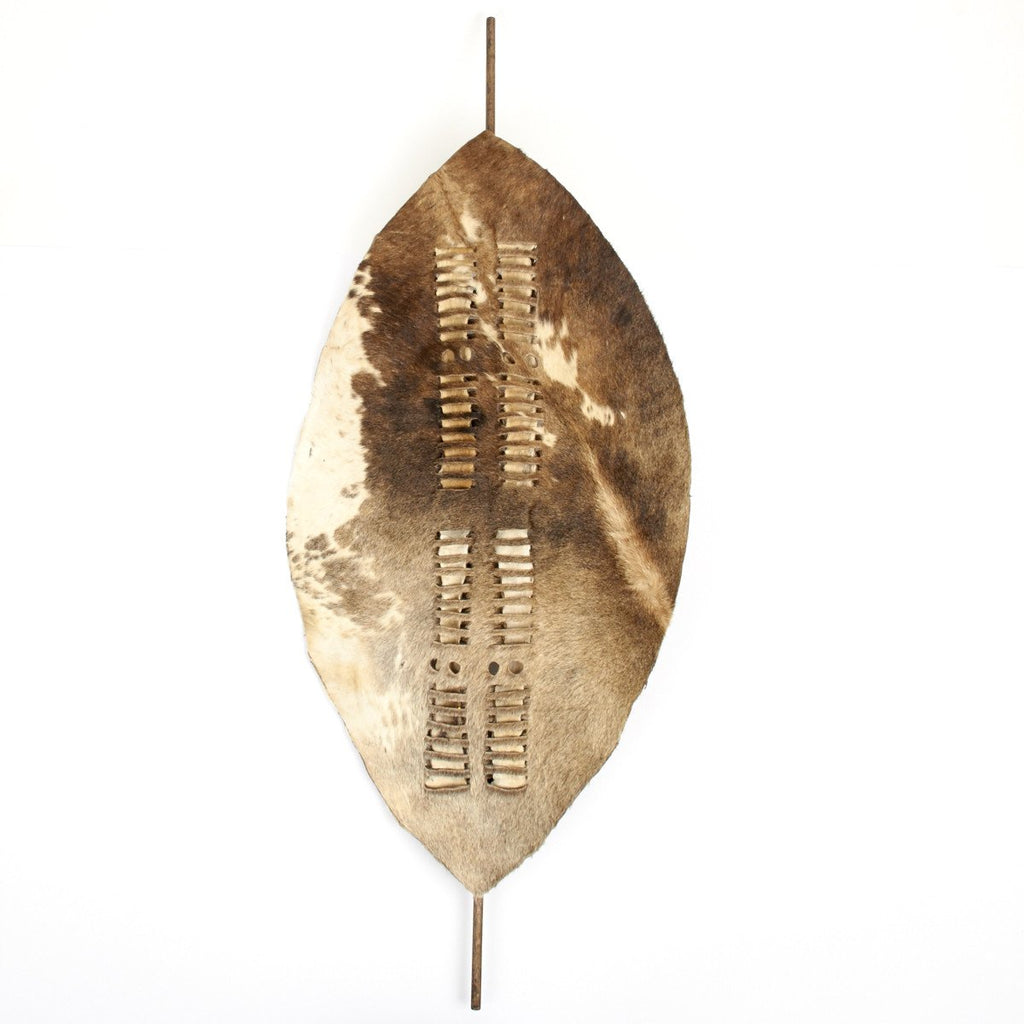Item Description
New Made Item: This is a beautiful reproduction of the traditional battle shield of the ZULU tribe warriors under their leader Shaka known as an Isihlangu. Every shield is hand made in the traditional fashion from a different animal so no two will be exactly the same meaning the color, pattern, shape, hide thickness, and other features will vary.
Approximate measurements:
Shield height: 36"- 38"
Shield width: 20"- 22"
Shaft Height: 46"- 48"
The making of Zulu shields, both for ceremony and war, was a specialized craft. Hide was taken from the back of an animal, pegged out in the sun to harden and dry then buried under manure for at least two days before being pounded with stones. The characteristic oval shape was cut and a central stick support secured by leather loops. Two columns of small horizontal slits were cut in the face of the shield and supple pieces of leather interwoven between them down each side of the stick to give the central section a double thickness.
Cow-hide shields known as Isihlangu were developed in the early 19th century by Shaka kaSenzangakhona, a great warrior king and innovator who transformed Zulu warriors into a potent military machine. Shaka also introduced a new short, stabbing spear and a new style of fighting whereby the Zulu could barge his enemy off balance with the shield, or use it to hook around his enemy's shield, pull it across his body and stab him under the left arm. These new weapons and methods, combined with tactical brilliance on the battlefield allowed the Zulu to conquer their neighbors, consolidate economic and military power, and resist European invasion for a long period.
The Zulu military system was based on the close bonding of unmarried men grouped by age. Brought together in a barracks at about 18-20 years old, a group of 350-400 men developed a strong identity as a 'regiment' or impi thanks to insignia such as the patterning on their shields. Each impi had its own kraal of cattle, and King Shaka assigned each a specific hide patterning. Impi kept their shields turned face-inwards under their arms while charging the enemy, until the last moment when the entire regiment turned their shields to face the enemy - who would only realize which of Shaka's regiments they faced with seconds to spare. This idea that the shield represented one's military identity is enshrined in the Zulu expression, "to be under somebody's shield", meaning to be under his protection.
Yet the different colors and markings on shields did more than just identify a specific impi. Great warriors had white shields with a few spots; the young and inexperienced had nearly black shields whilst the middle warriors had red shields. This demarcation formed the basis of the Zulu's famous battle formation imitating the horns, chest and loins of a cow, which is thought to have originated in hunting as a means of encircling game. During combat, the youngest and swiftest warriors, carrying dark shields, made up the 'horns', attempting to surround the enemy and draw him into the 'chest', whereupon the elite white shields would destroy him.
After a year of basic training, young warriors were sent home to tend their family cattle herds, mobilizing for active service for four months of each year thereafter. Impi were disbanded when the men reached their late thirties and, under Shaka, it was only then they could marry. However, by the time of Zulu War of 1879, in the reign of Cetewayo, the marriage age was much younger and married warriors were no longer regarded as inferior and could bear a white shield in battle. Whether a Zulu warrior was active or retired, his shield remained an important symbol of his status upon entering marriage.
- This product is available for international shipping.
- Eligible for all payments - Visa, Mastercard, Discover, AMEX, Paypal & Sezzle














